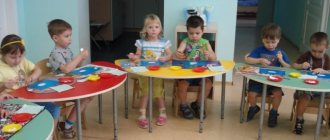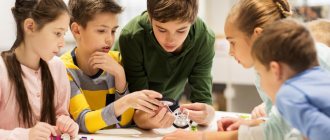Modern technologies for implementing a person-centered approach in preschool educational institutions
“Modern technologies for implementing a person-centered approach in preschool educational institutions”
Very often we hear. That a teacher should use educational technologies in his work. Which would meet modern educational requirements, this has become especially relevant with the implementation of the Federal State Educational Standards for Preschool Education, which completely change the system of educational work in preschool educational institutions. One of these priority technologies in pedagogy is student-oriented technology.
Person-centered technology
- this is an educational system where the child is the highest value and is placed at the center of the educational process.
Personality-centered education
is based on the well-known principles of humanistic pedagogy: the self-worth of the individual, respect for him, nature-conformity of education, kindness and affection as the main means.
In other words, person-centered education is the organization of the educational process on the basis of deep respect for the child’s personality, taking into account the characteristics of his individual development, treating him as a conscious, full participant in the educational process.
Objectives
of person-centered technology
:
- humanistic orientation of the content of preschool education activities;
- providing comfortable, conflict-free and safe conditions for the development of the child’s personality, realizing her natural potentials;
- priority of personal relationships;
- individual approach to students.
The forms of organizing activities using person-oriented technology are varied:
- games, activities, sports activities
- conversations, observations
— experimental and design activities
- exercises, gymnastics, massage
— trainings, sketches, figurative role-playing games
- competitions and exhibitions of children's creativity
Within the framework of person-oriented technologies, independent areas are distinguished:
1. Humane-personal technologies
, distinguished by their humanistic essence, psychological and therapeutic orientation in providing assistance to a child with poor health, during the period of adaptation to the conditions of a preschool educational institution.
This technology
can be well implemented in preschool institutions where there are rooms for psychological relief.
Music and physical education rooms, classrooms for the environmental development
of preschoolers and productive activities, where children can choose an activity of interest. All this contributes to comprehensive respect and love for the child, and faith in creative powers.
2. Collaboration technology
implements the principle of democratization of preschool education, equality in the relationship between teacher and child, partnership in the system of relationships
“Adult - child”
.
The teacher and children create conditions for a developing environment
, produce manuals, toys, and gifts for the holidays.
Jointly determine a variety of creative activities (games, work, concerts, holidays , entertainment)
The basis of personally oriented technology
is an emotionally comfortable climate in the group and meaningful, personality-oriented interaction between the teacher and children.
Therefore, the teacher’s position towards children includes showing respect for the personality of each child and friendly attention to him.
Organizing personality-oriented interaction specifically in free activity requires a lot of effort from the teacher, understanding, recognizing the child, accepting him as a full-fledged partner, and providing him with assistance. As well as searching for new methods of organizing work (for example, maintaining discipline in a group).
You can use the following techniques of a person-centered approach.
“Silence duty” technique.
Target
use of this technique: maintain discipline in independent games. Together with the children, we select one or two people on duty who keep order in the group. We put on a cap with an emblem for the duty officer. This greatly stimulates the desire of other children to be on duty, and for this, accordingly, behave calmly and listen to the person on duty. We offer the most naughty and noisy ones to sit at the table for a few minutes. They can be used for puzzles, material for modeling, drawing, etc. Then, having calmed down, this child returns to his game. The game gives each child the opportunity not only to get used to a calm environment, but also to express himself, evaluate himself, raise his authority in the eyes of other children, teaches him to analyze (the guys praised me, noted me, they will listen to me...)
2. When organizing various activities during the day, you can use the “Colored Palms”
- three silhouettes of a palm - a signal. Using this technique helps children develop self-organization skills and allows the teacher to avoid unnecessary instructions.
Red palm
- “shout” means that you can run, jump, make noise (walking, sports competitions, independent motor activity).
Yellow palm
– “whisper”, a signal that you need to move quietly and speak in a low voice or whisper (tour of the garden, going to bed, free games, manual labor, etc.)
blue palm
- “silent”, you should sit quietly, be silent (while reading fiction, when an adult is speaking).
A necessary condition for the use of personality-oriented technology is taking into account the individual characteristics of each child
.
Observations
looking after children during the day helps to better understand the habits and characteristics of each child, what difficulties they experience, and how you can help him, if necessary.
Using an individually differentiated approach
, it is possible to divide pupils into conditional groups, taking into account the characteristics of the development of mental processes, taking into account the state of health of children, the degree of mastery of program material, and interest in learning new things.
As a result of the use of personality-oriented technologies,
teachers have the opportunity to build an individual educational route for students.
In order to fully implement personality-oriented technology, an appropriate developmental environment for the group is necessary,
which allows the child to show his own activity, to realize himself, his capabilities and interests to the fullest. The developmental environment should be variable, dynamic and transformable, constantly updated in accordance with planning. This is ensured by the availability of material, its diversity and constant updating. The introduction of new, completely unfamiliar materials stimulates children to creative exploration.
Each child in the group should have the opportunity to do what he likes most (creativity, play, cognitive activity, etc.).
The task
In this case, the teacher is to provide assistance to each child in revealing his inner world, providing him with additional strength in search of new discoveries and meanings, in building a comprehensively developed personality.
The use of various forms of organizing children's activities gives positive results for this. For example, some of them: one of the forms of interaction between a teacher and children
is “children’s collecting” “children’s collecting” various objects - storage stones, pebbles, shells, kinder surprises, soft toys, souvenirs, magnets, etc. Creating collections gives children the opportunity to engage in searching -research activities, makes you want to share or exchange your interesting exhibits, talk about them. Children, together with the teacher, systematize and study what they collect. The collected exhibits of the collections are distributed by topic, they can be placed in containers and placed on a shelf for free access: children can take them and add new exhibits.
Competitions and exhibitions of children's creativity have become a popular form of work in preschool educational institutions. They help develop children's creative abilities and satisfy their ability to express themselves. In the “Creativity Corner” any child can place their crafts and drawings made in kindergarten or at home.
An integral part of a personality-oriented approach to a child is the disclosure of his individual abilities and talents. Therefore, various circles and sections have long been an integral part of one of the forms of organizing a child’s activities in a preschool educational institution.
If a child attends club classes with enthusiasm, then this alone creates a situation of success for him, and therefore increases personal self-esteem. Certainly
,
each teacher brings
something of his own, individual into the pedagogical process. Pedagogical individuality is determined by the level of understanding of the content of the program, the equipment of the pedagogical process, and the conditions in which children find themselves.
Modern pedagogy involves the use of many technologies. But personality-oriented technology should be a priority, since its use contributes to the formation of a comprehensively developed personality who can adapt to modern society.
Experience in using student-centered technologies in a preschool institution
The goal of a teacher’s work in a preschool educational institution is to preserve the psychological and somatic health of children within the framework of correctional and developmental education, taking into account the programs used in kindergarten. Based on this, the educator must use educational technologies that meet modern requirements. Over the past five years, I have been actively using modern educational technologies, which has become especially important with the introduction of the Federal State Educational Standards, which completely change the system of educational work in preschool educational institutions. Correctional speech therapy work must comply with the principle of developmental education, the goal of which is the development of the child. Therefore, the use of person-oriented technologies in my work has acquired particular importance. Personality-oriented technologies are based on subject-subject relationships between the teacher and students. Personally-oriented learning is based on the recognition of the uniqueness of the child’s own subjective experience as an important source of individual life activity, manifested, in particular, in the development of linguistic reality.
With the help of personality-oriented technologies, I was able to implement an individually differentiated and active approach to the upbringing and training of children, the principle of unity of diagnosis and correction. Person-centered technologies can be used in the following forms:
- 1. Construction of an organizational moment for the lesson as a whole or for a specific task. At the same time, children are presented with a problematic situation that needs to be solved. Children put forward hypotheses, propose solutions to problems, and choose the best solution. Thus, the problem becomes an inductor that motivates children to work, and also allows them to formulate the topic of the lesson on their own. For example, a speech therapist suggests a problem for a task on word formation with diminutive suffixes: “Guys, look who came to our lesson (Kitten). A kitten is a very affectionate animal. How do you think, since he is so affectionate, how will he talk? (Children reason and come to the conclusion that the hero will call all objects affectionately, diminutively) That’s right, now we will call these fruits affectionately.” This gives preschoolers the opportunity to independently formulate a task and be able to come to an agreement.
- The use of dramatizations and sketches when conducting classes on the development of coherent speech. This technique helps to make the child an active subject of activity, allowing him to realize himself in theatrical activities. At the same time, children are allowed to choose their own roles and distribute them among themselves, taking into account the individual needs and capabilities of the participants in the performance. After conducting an etude or staging, mandatory discussion, reflection and summing up are necessary. I use this type of activity when planning classes on the development of coherent speech, which helps to increase motivation for the lesson, development of the intonation-expressive side of speech, the emotional sphere, and regulatory qualities of the individual.
3. Construction of individual correctional routes based on the diagnosis of mental and speech characteristics of children. This applies to activities specific to each individual child, as well as to the age characteristics of children. For example, when drawing up a correctional route for a child prone to visual activities, tasks like “Draw, color, circle the dots” will be more often offered; a child with mathematical abilities can be asked to count pictures, sounds, phrases, etc.; For children who like, for example, animals or plants, appropriate vocabulary and illustrative material are selected.
Thus, I actively and daily use personality-oriented technologies, which allows me to approach the upbringing of children from the standpoint of modern pedagogy and psychology. Traditional methods and techniques are successfully processed, brought into compliance with the Federal State Educational Standard and successfully implemented in the process of correctional and speech therapy work.
Teacher of preschool educational institution compensatory kindergarten No. 7
Mokeeva E.A.


